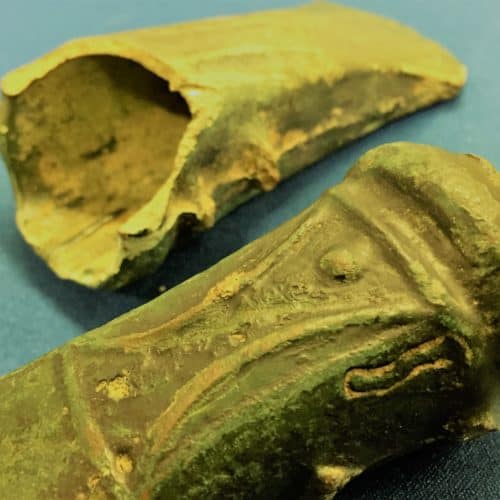Stone Age to Iron Age activity 3: buried Bronze Age hoard
Investigate the contents of the Saltwood hoard.
- Who buried it and why?
- Were they in danger, fleeing for their life?
- Or was it buried for a completely different reason?
- What clues are there to their identity?
- What can it reveal about Bronze Age life?
Imagine you’re the person who buried it. Tell us your fascinating story.
Learning objectives
Increased knowledge and understanding of Bronze Age metal working, hoards and bronze tools and weapons.
Research skills.
Design technology skills.
Curriculum links
KS1-2 History (Stone Age).
KS1-2 Design technology (Make and test a stone Age tool or weapon)
Show the class the photo of the Saltwood Bronze Age hoard in Learn with Objects Stone Age to Iron Age 16: Bronze hoard.
Tell them that the objects were unearthed at Saltwood near Folkestone, by workmen digging a tunnel for the Hythe to Sandgate Railway in 1872. Seventy objects were discovered in total, of which 14 are now in the care of Folkestone Museum.
Ask pupils the following questions to see if they can come up with some initial ideas about what the objects might be and why they were buried.
- What material are the objects made from?
- How would you describe them - colour, texture, weight?
- How were they made?
- How many different kinds of object are there?
- Are they complete?
- Who might they have belonged to?
- Why were they were buried?
- If somebody hid them, why didn’t they come back?
- When do you think they were made?
Through this discussion, introduce the children to the subject of the Bronze Age, and that Bronze Age people were living in the Folkestone area, before the town was built. We know about their lives from the evidence they left behind.
The children research Learn with Objects Stone Age to Bronze Age 16: Bronze hoard and other websites, to find out more about this hoard and others elsewhere.
Below are links to some excellent resources you can use in the classroom. This BBC video shows how bronze is made, from raw materials to finished axe head.
Here’s a great Museum of London video showing the smelting of a bronze axe.
https://www.youtube.com/watch?v=Ohij1e2oZio&index=2&list=PLcUgvdvJPCKdKaEh2uRhz64K-7tA6wa8h
Here you can view and rotate a Bronze Age axe head in 3D.
Info and images of the Burton and Isleham Bronze Age hoards, two of the finest in Britain. See sections 7 and 8. With worksheets for KS1-2 pupils. http://www.coreknowledge.org.uk/resources/Resource%20Pack-%20Year%201-%20Prehistoric%20Britain.pdf
A hoard of stories
Use the Saltwood hoard as the starting point for a piece of descriptive writing. Here are just a few ideas:
- Imagine you’re an artefact from the Saltwood hoard. Tell us your life story from your rocky origins, and birth through smelting, to use as a tool or weapon.
- Perhaps you performed well in battle, or helped build a roundhouse, or the Dover Bronze Age boat?
- Describe your burial and long dark wait underground, before re-discovery, display in the museum… and world-wide fame through the Learn with Objects website!
Drama and role play
- Create a piece of role play or drama in six short scenes based on the story of the Saltwood hoard. Small groups of children can be given a scene each to research, plan and rehearse, before a gala performance in front of the whole class.
The six scenes might be…
- The mining and crushing of the metal ore
- The casting and smelting process
- The use of the artefacts as tools and weapons
- Frantic burial of the hoard and pursuit by an enemy
- Rediscovery during the building of the railway tunnel
- Putting the hoard on display today… as star exhibits of an exhibition
Children play the part of the Bronze Age, Victorian and modern-day people involved. They can dress in character and make simple props, or improvise with their bodies. The performance can have sound and dialogue or be silent. Think of ways to add drama, jeopardy and humour to the performance.
Creative writing and poetry
This activity gives children the start of each line for a piece of descriptive writing or poetry inspired by the different types of artefact in the hoard.
The challenge is to compete the sentences as imaginatively as possible to describe each object or what it does.It can be completed either as a writing exercise, or a verbal game with the children sat on the mat.
Cardboard cut-outs of the different types of object can be made in advance by the children, then picked out of a sack, like the one archaeologists believe the hoard was originally buried in. The children say what they think each object is and complete the sentence…
- I am the ingot…
- I am the axe…
- I am the spearhead…
- I am the blade…
- I am the sword…
- I am the chisel…
- I am the chape…
- I am the linch pin…
- We are the hoard…
NB A chape is the protective fitting at the bottom of a scabbard for a sword or dagger), a linch pin is the chunky metal pin that holds on the wheel of a cart or chariot.
Here are a few examples.
- I am the ingot smelted from rocks…
- I am the chisel that shaves away wood…
- I am the sword that flashes and stabs…
- We are the hoard buried far below ground…
The sentences can then be extended into a longer piece of creative writing or a poem. Alternatively, children can write the sentences can written onto large sheets of light card to decorate the classroom.

